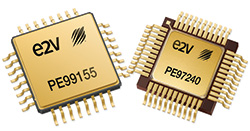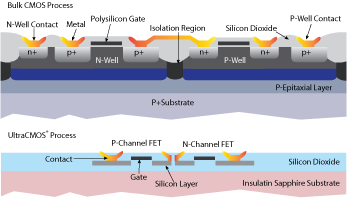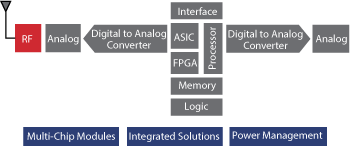
Three…two…one…blast off! As a rocket or satellite launches into space, it exits the protection of the Earth’s atmosphere and enters an environment that poses design challenges. From extreme temperatures and radiation to power consumption, there are simply more factors in play when designing electronic systems for space. Space applications require higher levels of performance and reliability from semiconductors.
Radiation 101
To meet the tough demands of the space environment, semiconductor products must be radiation-tolerant. The effects of radiation can be devastating if the ICs are not properly designed and tested to survive in this harsh environment. The primary radiation concerns in space are total ionizing dose (TID), enhanced low dose rate sensitivity (ELDRS) and single event effects (SEE).

TID degradation or gain drift of component parameters change circuit supply and leakage currents, threshold voltages and propagation times. Program missions will determine the level of TID tolerance required. For example, low-Earth orbit (LEO) missions have lower lifetimes and may require 30 to 50 kRad(Si), while deep space, longer lifetime missions may require 100 kRad(Si) or more.
ELDRS can degrade certain types of bipolar devices more severely at very low dose rates than at higher dose rates. Semiconductors based on bipolar technology are subject to “enhanced” total ionizing dose degradation at very low dose rates.
SEEs occur when a high energy particle passes through the active region of a semiconductor, triggering nondestructive effects such as upset, multiple bit upset or analog transients or destructive effects such as latch-up, gate rupture and burnout. As a high energy charged particle enters the silicon at a high velocity, it exerts a force on the bound electrons and separates them from the lattice, freeing substantial local charge to be collected across any junction within a diffusion length. The collection produces current spikes that have various effects on the circuit. Non-destructive or “soft error effects” momentarily or permanently change the state of a device or cell/node, affecting its functionality. These types of errors are defined as single event upset (SEU), single event transient (SET) and single event functional interrupt (SEFI) errors. Destructive or “hard-error effects” interrupt device function and can permanently damage the device without prompt external mitigation. These types of errors are defined as single event latch-up (SEL), single event gate rupture (SEGR) and single event burnout (SEB).
Radiation-Tolerant Semiconductors
Peregrine Semiconductor addresses the demands of the space market with its UltraCMOS® technology, an inherently radiation-tolerant platform. For high-reliability products,
UltraCMOS circuitry is processed on an ultra-thin silicon layer atop a dielectric sapphire wafer. Variable capacitances in the junction region are virtually eliminated, reducing the overall current drain and improving the transistor’s voltage handling and linearity. Peregrine’s high-reliability products do not contain the bulk parasitics found in standard CMOS devices, making latch-up impossible (see Figure 1).

Products based on UltraCMOS technology are SEE tolerant, SEL immune and can deliver 100 kRad(Si) TID. The ultra-thin epitaxial layer in UltraCMOS technology produces the lowest possible SEU charge collection of any production silicon technology and simplifies the circuit design to achieve SEU, SET and SEFI immunity. UltraCMOS device construction eliminates four-layer devices and all forms of latch-up, including SEL. The device design rules constrain operating voltages to less than one-third BVox, which prevents any SEGR. SEB is not observed in this technology, where high current bipolar junction transistor (BJT) gain is absent by construction. CMOS technology does not use bipolar (minority carrier) elements and does not exhibit
ELDRS. UltraCMOS technology is an
ELDRS-free process.
Peregrine manufactures a broad portfolio of high-reliability products for space applications, including phase-locked loops (PLL), prescalers, mixers, digital step attenuators (DSA), switches and point-of-load (POL) DC-DC converters. Two new Peregrine products showcase the capabilities of UltraCMOS technology in space: the PE97240 PLL and the PE99155 POL DC-DC buck regulator.
The PE97240 is an integer-N PLL that provides superior phase noise performance for signal precision and frequency stability. It is radiation tolerant to 100 kRad(Si) TID and immune to SEL. Power consumption is a low 75 µA at 2.7 V, enabling engineers to reduce power demand. Offered in an RoHS compliant, 44-lead, hermetically sealed CQFP package, the PE97240 consists of a dual modulus prescaler, counters, a phase detector and control logic. The PE97240 has an integer-N frequency synthesizer that generates multiple output frequencies from a single reference input frequency. This divided down output enables reference and phase detection at lower frequency, and it handles both frequency and phase lock. With PLLs, phase noise is an important measure of the signal’s spectral purity. Lowering phase noise reduces phase jitter and noise, which offers RF engineers high signal precision and solid frequency stability. Phase noise is a product of thermal noise, which is expressed by the floor figure of merit (FOMfloor) and low frequency flicker noise, which is expressed by the flicker figure of merit (FOMflicker) within the system. The PE97240 achieves an industry-leading maximum FOMfloor of 227 dBc/Hz with the 5/6 prescaler and -225 dBc/Hz with the 10/11 prescaler; the PLL also sets the bar with a FOMflicker of -265 dBc/Hz with the 5/6 prescaler and -259 dBc/Hz with the 10/11 prescaler.
Peregrine’s UltraCMOS technology also addresses the demands of power management. The PE99155, a POL buck regulator, regulates the power for NASA’s SpaceCube 2.0 Hybrid Science Data Processor. Peregrine’s PE99155 helped the NASA design team meet its goal of delivering “order-of-magnitude improvements” in on-orbit computing performance over traditional flight computing systems. The SpaceCube 2.0 design uses four of Peregrine’s PE99155 power management chips to provide regulated power at multiple supply voltages for the processing elements, memory and associated circuitry, like oscillators and gigabit transceivers. Peregrine’s flexible and small form factor design allowed all of the regulation functions to be placed on a single printed circuit board (PCB), realizing area and overall power consumption savings over the SpaceCube 1.0 power design, which required multiple PCBs using conventional linear regulator bricks.
Available Through e2v
Peregrine’s entire portfolio of RFICs and DC-DC power management space products is now available through e2v. Announced in February 2016, this strategic relationship combines Peregrine’s expertise and track record in high reliability RF and power management products with e2v’s leadership position in aerospace and defense semiconductor products. The agreement broadens e2v’s product offering to include RF. The e2v portfolio now spans the signal chain from RF to back-end, including data converters, memory and high performance data processing (see Figure 2). e2v has a portfolio of over 3,600 QML-approved products — one of the largest high reliability portfolios in the market. Through relationships with semiconductor manufacturers like Peregrine, e2v supports complete QML solutions to help aerospace customers solve their design challenges.
Peregrine Semiconductor
San Diego, Calif.
www.psemi.com
e2v inc
Milpitas, Calif.
www.e2v-us.com
